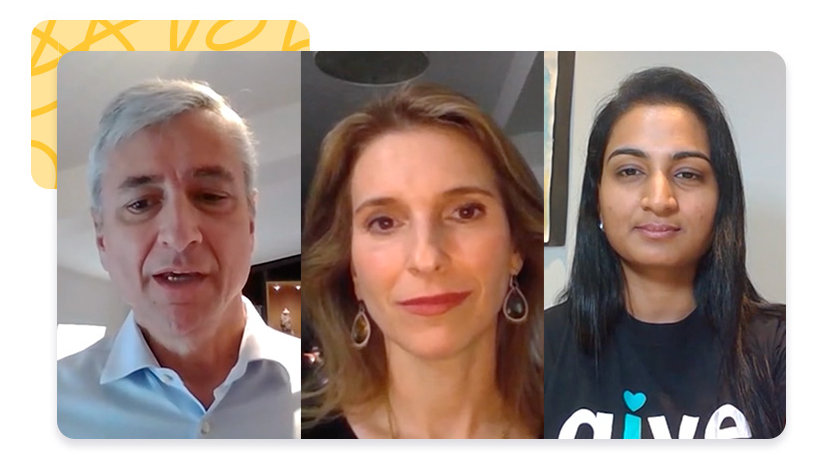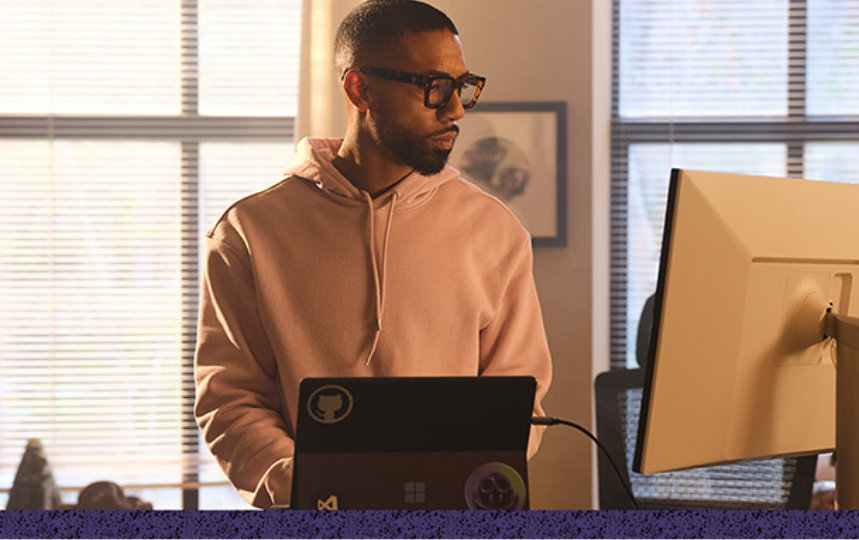Many experiences. Shared purpose.
We’re learning every day how to build a culture where each person feels seen, supported, and empowered to grow—together.

What it means to be a good-ish ally
NYU Professor Dolly Chugh shares insights from The Person You Mean to Be, inviting us to embrace the discomfort of growth and the idea of being “good-ish” as we work toward more inclusive, self-aware workplaces.

Leading with empathy when it matters most
In a conversation about leadership in times of uncertainty, Lindsay-Rae McIntyre, Chief Diversity Officer and Corporate Vice President of Talent and Learning at Microsoft, reflects on the role of empathy, care, and accountability in shaping a culture where people can navigate uncertainty—together.

Avoiding the trap of surface-level inclusion
Dr. Tanya Hernández explores how individuals and organizations can unintentionally sidestep the real work of inclusion—and why recognizing rhetorical deflection is key to building lasting cultural change.

Making space to grow—together
Eduardo Briceño, co-founder of Wiring Growth, explores how adopting a growth mindset can help teams navigate discomfort, build trust, and turn mistakes into momentum. It’s a reminder that inclusion requires curiosity, not perfection.
Many places. One commitment.
We show up across communities with humility and purpose—recognizing that listening, learning, and evolving go hand in hand.

Inclusion Insights: AI and Innovating an Inclusive Future
Lindsay-Rae McIntyre, Chief Diversity Officer and Corporate Vice President of Talent and Learning at Microsoft, joins Ashley Llorens, Vice President and Distinguished Scientist, to discuss why building responsible AI starts with diverse perspectives and bold, ethical inquiry.

Inclusion Insights: Inclusive Workforces for Global Impact
Lindsay-Rae McIntyre, Chief Diversity Officer and Corporate Vice President of Talent and Learning at Microsoft, explores how inclusive teams fuel innovation, resilience, and global business success.

Atlanta: Perspectives on Inclusion in the U.S.
Cornelius, Navtej, and Judson Althoff, Executive Vice President and Chief Commercial Officer, reflect on intersectionality, the power of employee communities, and how diverse voices shape stronger, more connected organizations.

Beijing: Perspectives on Inclusion in China
Roan, Zhi, and Rajesh reflect on the layers of identity in China’s evolving workplace—sharing perspectives on allyship, gender equity, and the importance of recognizing diversity within diversity.

Hyderabad: Perspectives on Inclusion in India
Meetul, Nidhi, and Jason share how inclusive work environments are shaped by cultural context, family dynamics, and the need for thoughtful accommodations—especially in hybrid and remote settings.

London: Perspectives on Inclusion in the UK
Clare, Zephanaiah, and Amy reflect on Black British history, the impact of intentional allyship, and how employee communities create connection, accountability, and space for progress.

Mountain View: Perspectives on Inclusion in the U.S.
Rukmini, Eren, and Phil share insights on introspection, the risks of building without representation, and how everyday actions can strengthen allyship and shape better products.

Munich: Perspectives on Inclusion in Germany
Marianne, Magdalena, and Kevin discuss inclusive language, the power of reverse mentoring, and how intentional allyship helped sustain culture and connection through uncertain times.

Nairobi & Lagos: Perspectives on Inclusion in Kenya and Nigeria
Gafar, Otilia, and Kurt share reflections on authenticity, identity within identity, and the role of storytelling in shaping culture. They explore how proactive allyship—especially around LGBTQIA+ communities—can foster safety, trust, and connection.

São Paulo: Perspectives on Inclusion in Brazil
Tanya, Andre, and Chris discuss the importance of representation, inclusive hiring practices, and how intentionality at every stage of the employee experience builds stronger, more equitable workplaces.

Singapore: Perspectives on Inclusion in Singapore
Andrea, Sindhura, and Jean-Philippe highlight approaches to supporting employees with disabilities, the power of representation, and the role of empathy in hybrid work and inclusive leadership.

Sydney: Perspectives on Inclusion in Australia
Steven, Elizabeth, and Brad explore multiculturalism, the significance of Australian Indigenous communities, and practical strategies for fostering cross-cultural awareness and an inclusive workplace.

Tel Aviv: Perspectives on Inclusion in Israel
Michal, Tamer, and Scott discuss proactive inclusion strategies, the business case for diverse representation, and the critical importance of gender equity.

Tokyo: Perspectives on Inclusion in Japan
Hitoshi, Keiko, and Kathleen share insights on advancing equal opportunities for women, supporting early-career recruitment, and fostering allyship for LGBTQIA+ colleagues.

Global Opportunity for Inclusion
Insights from Dr. Tanya Hernández, Professor of Law at Fordham University; Prof. Kenji Yoshino, Professor of Constitutional Law at NYU; and Dr. Balmurli Natrajan, Professor of Anthropology and Social Justice at William Paterson University, explore how to move beyond moments and embrace lasting inclusion within organizations worldwide.

A Historical Perspective on Inclusion
Dr. Balmurli Natrajan, Professor of Anthropology and Social Justice at William Paterson University and faculty at Azim Premji University, reflects on the history and evolution of modern inclusion and multiculturalism.

The Global Conversation on Inclusion
Lindsay-Rae McIntyre, Chief Diversity Officer and Corporate Vice President of Talent and Learning at Microsoft, highlights the importance of understanding inclusion as a truly global dialogue—not confined to any one region.
Many voices. One culture.
Explore stories that reflect our journey to foster a culture of connection, accountability, and care. From employee voices to leadership reflections, these perspectives offer insight into how we grow stronger through shared experience—and a shared sense of responsibility.

Age: Generational Inclusion
Dr. Ken Dychtwald, psychologist and gerontologist, examines the dynamics of multiple generations working side-by-side and highlights the importance of awareness and nuance in addressing age-related biases.

Disability: Increasing Access and Understanding
Charlotte McClain-Nhlapo, Global Disability Advisor at the World Bank Group, explores the diversity within the disability community and why organizations must deepen their understanding to foster true inclusion.

Faith: Conversations in the Workplace
Rev. Mark Fowler, CEO of Tanenbaum, and Dalia Mogahed, Director of Research at the Institute for Social Policy and Understanding, discuss how recognizing faith as part of workplace inclusion can enhance culture and connection.

Gender: Opportunities for Women in the Workplace
Dr. Deborah Gruenfeld, Co-Director of Stanford University’s Executive Program in Women’s Leadership, discusses how organizations can create more inclusive conversations and policies that support women. She highlights workplace inequities and the chance to advance equality across all genders.

Mental Health: Support in the Workplace
Dr. Kayla Follmer, Assistant Professor of Management at West Virginia University, explores ways to make workplace inclusion more welcoming for employees with mental health conditions. She emphasizes the role of managers and peers in providing meaningful support.

Neurodiversity: Autism and Inclusion
Dr. Ami Klin, Director of the Marcus Autism Center at Emory University School of Medicine, explains how workplaces can better include neurodiverse individuals, particularly those on the autism spectrum. She also highlights the value of retaining neurodiverse talent beyond just accommodation.

Race & Ethnicity: Black and African American Community
Dr. Lawrence D. Bobo, Dean of Social Science and W. E. B. Du Bois Professor at Harvard University, discusses how organizations can foster more inclusive conversations and environments for Black and African American employees. He also addresses the need to confront stigmas, hate, and violence in the workplace.

Race & Ethnicity: Ideal Affect and the Asian Community
Professor of Psychology at Stanford University, Dr. Tsai discusses her research on ideal affect and the cultural shaping of emotion. She explores how workplace perception and expectations impact inclusion for many, including those in the Asian community. Watch to better understand the concept of ideal affect and some of the biases that can surface for us all.

Race & Ethnicity: Indigenous Community
Dr. Linda Tuhiwai Smith, Professor at the University of Waikato, highlights ways organizations can better include Indigenous voices and experiences. She also addresses workplace stigmas and policies that uniquely impact Indigenous employees.

Race & Ethnicity: Hispanic and Latinx Community
Dr. G. Cristina Mora, Associate Professor of Sociology and Chicano/Latino Studies and Co-Director of the Institute of Governmental Studies at UC Berkeley, explores how organizations can deepen inclusion for the diverse Hispanic and Latinx communities. She highlights the rich diversity within these groups and the opportunities to better support employees.

Smithsonian Latino Center: History, Culture, and Impact
Eduardo Díaz, Director of the Smithsonian Latino Center, discusses the importance of historical and social understanding of the Hispanic and Latinx community. This insight supports organizations in building more inclusive workplaces, ahead of the opening of the Molina Family Latino Gallery.

Covering: Impacts on Employee Effectiveness and Authenticity
At Build 2021, Kenji Yoshino, Chief Justice Earl Warren Professor of Constitutional Law at NYU, and Lindsay-Rae McIntyre, Chief Diversity Officer and Corporate Vice President of Talent and Learning at Microsoft, discuss workplace “covering” — how employees hide aspects of identity, its effects on effectiveness and authenticity, and what leaders can do to foster more genuine inclusion.
Discover how Microsoft’s culture of inclusion powers innovation
We’re building a workplace where every identity is seen, every voice is valued, and our collective growth fuels global impact. Explore how we bring our values to life—together.

Diversity & Inclusion
We believe in the transformative power of engaging many different perspectives.

Inside Microsoft
We stay focused on increasing representation and strengthening a culture of inclusion so that employees can bring all of who they are, do their best work, and thrive.

Annual Report
With our annual diversity & inclusion report, we transparently share workforce data and our progress on our commitments. We continually evaluate where we are now and where we aspire to be, to inform our action.

Beyond Microsoft
We have an opportunity—and an obligation—to foster collective movement towards greater diversity and inclusion within and beyond Microsoft through our actions and partnerships.


Follow Microsoft